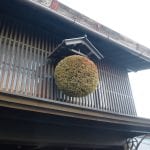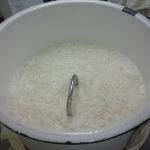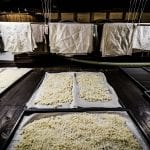Old and new can co-exist
 I recently shared a glass of sake or three with a brewer that is half my age. That itself ain’t saying much, getting up there as I am, but my real point is that he is clearly of the “changing of the guard” group of brewers in the industry. In other words, he is of the generation that has recently taken over that is chock full of new ideas.
I recently shared a glass of sake or three with a brewer that is half my age. That itself ain’t saying much, getting up there as I am, but my real point is that he is clearly of the “changing of the guard” group of brewers in the industry. In other words, he is of the generation that has recently taken over that is chock full of new ideas.
And one of those is pasteurization. More specifically, there is a solid trend of pasteurizing sake only one time amongst many (young) sake brewers these days. To summarize the issue, sake is pasteurized by heating it to 65C or so to stabilize it. Leaving it unpasteurized (nama) leaves it susceptible to going bad. Pasteurizing it kills any suspect bacteria and deactivates the enzymes that would help feed them. If it is not pasteurized, it needs to be kept refrigerated to prevent the offending chemical reactions from taking place.
Usually this is done twice, once after brewing and before maturing for a few months, and once again after the maturing period is finished, just before bottling. However, either the first or the second can be avoided – and stability can be ensured – by either maturing in bottles so as to spare the sake exposure to the air, or keeping the sake cold during that maturation period. Either will work; so will both together.
Why bother? Because pasteurizing can in fact strip some character from the sake. The less you have to mess with it, the fresher it will be.
Basically. Yet, the other side of the pasteurization coin is that pasteurized sake can have more depth and resonance than nama (unpasteurized) sake. Some nama tastes and smells like nama – and not much else.
However, undoubtedly there is a trend toward pasteurizing only once rather than twice. And it seems more common in sake made by younger brewers with the willingness to try new things.
 Still, the half-my-age-brewer in question is perhaps a bit more traditional than most. He is also technically very adept via both education at the Tokyo Agricultural University Brewing Studies department, and experience, having worked in a brewery his whole (short) life. He still pasteurizes his sake twice, knowing well that it does not need to detract at all from quality or liveliness if done properly. Also, his sake is a bit more solid and earthy than most, and therefore more tolerant of such handling. Or so I think.
Still, the half-my-age-brewer in question is perhaps a bit more traditional than most. He is also technically very adept via both education at the Tokyo Agricultural University Brewing Studies department, and experience, having worked in a brewery his whole (short) life. He still pasteurizes his sake twice, knowing well that it does not need to detract at all from quality or liveliness if done properly. Also, his sake is a bit more solid and earthy than most, and therefore more tolerant of such handling. Or so I think.
And so, Half-my-age was at a conference of brewers, discussing quality and trends, run by a distributor of an outstanding lineup of sake that is not the least bit shy about sharing his opinions of how things should be, reality be damned. When Half-my-age described how he still pasteurized twice, Not-the-least-bit-shy retorted, “Hm. I didn’t know there were any sake brewers at all that still pasteurize twice!”
That must have smarted. Or rather, that would have smarted a bit to most, but Half-my-age has a temperament that lets it all roll off his back, and the confidence of one who with education and experience to know better. Not-the-least-bit-shy has neither.
His reply was, “If you keep the sake appropriately chilled for the months between pasteurizations, character and quality are one hundred percent maintained.” And he added, “one should repudiate nothing” in the sake world.
“Repudiate nothing.” That is something we would all do well to remember as we trek through the world of sake.
 The above example with Half-my-age and Not-the-least-bit-shy is but one example about one small step of the brewing process. “Repudiate nothing” applies to any step in the process: new yeast versus old yeast, scales of operation, automation in brewing. It also applies to marketing methods as well. When something new comes along that holds promise, that does not automatically negate something old.
The above example with Half-my-age and Not-the-least-bit-shy is but one example about one small step of the brewing process. “Repudiate nothing” applies to any step in the process: new yeast versus old yeast, scales of operation, automation in brewing. It also applies to marketing methods as well. When something new comes along that holds promise, that does not automatically negate something old.
Of course, this goes both ways. Just because things have been done one way for a thousand years does not mean that a new way could not possibly better. Repudiate not the modern methods either.
Also, things cycle. What was old becomes new again. New ideas get tried, and reborn after some adjustment. Everything is valid; nothing should be discounted or rejected.
This is not a philosophical exercise; it is a very worthy effort. If we think that because a sake is made a particular way, be it yamahai or by a large brewer or using modern yeast, then it cannot possibly be good, or as good, or definitely taste a particular way, then we rob ourselves of potentially enjoying something special.
Certainly, not everyone will agree. There are those that will insist that only the old traditional ways, methods and styles are proper. And there will likewise be those that disdain anything older than a decade or so. But heed them not. Like all things sake, balance is the key. Nevertheless, to “repudiate nothing” will surely make sake more enjoyable for you.
~~~~~~~~~~~~~~~~~~
Sake Professional Course in Denver, Colorado
August 28-30, 2017
 From Monday August 28 to Wednesday August 30, 2017, I will hold the 27th North American running of the Sake Professional Course at the University of Denver, (Fritz Knoebel School of Hospitality, Daniels College of Business) in Denver, Colorado. The content of this intensive sake course will be identical to that of the Sake Professional Course held each January in Japan, with the exception of visiting sake breweries.
From Monday August 28 to Wednesday August 30, 2017, I will hold the 27th North American running of the Sake Professional Course at the University of Denver, (Fritz Knoebel School of Hospitality, Daniels College of Business) in Denver, Colorado. The content of this intensive sake course will be identical to that of the Sake Professional Course held each January in Japan, with the exception of visiting sake breweries.
The course is recognized by the Sake Education Council, and those that complete it will be qualified to take the exam for Certified Sake Specialist, which will be offered on the evening of the last day of the course.
You can learn more about the course here, see the daily syllabus here,and download a pdf here. If you are interested in being in the mailing list for direct course announcements, please send me an email to that purport.
Testimonials from past graduates can be perused here as well.




